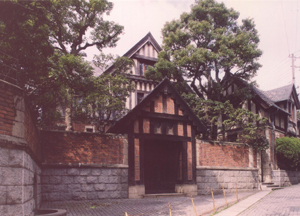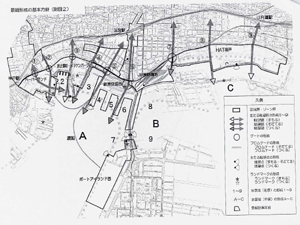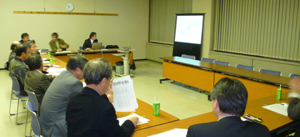 目次へ
目次へ
|
災害後の復興計画の策定をめぐって―ニューオリンズの現状― |
ローリー・ジョンソン
(米国都市計画家協会認定プランナー、コンサルタント、カリフォルニア州サンフランシスコ在住、UNOPの策定に災害復興・リスクマネージメントに関するコンサルタントとして関わる)
ラファエル・ラブラシス
(GCR & Associates,Inc.所属のプランナー、ルイジアナ州ニューオリンズ在住、UNOPの策定にデータマネジメントと地区計画チームのコーディネータとして関わる)
翻訳:牧紀男(京都大学防災研究所巨大災害研究センター助教授)

|
| ローリーさん・SFの自邸で/060418 |
ハリケーン・カトリーナの被害は、ニューオリンズの社会のあらゆる側面に及んでいるといっても過言ではない。甚大な被害を与えたハリケーンの上陸から一年半が経過した日の各地方紙の見出しは、軒並み、「インフラ、未だ完全に復旧せず」、「生活を行う上で不可欠な基本サービスの復旧、未だまだら模様」、「カトリーナ以前から問題の経済・公的な教育・犯罪が、より深刻に」といった、カトリーナの被害やその後の復興に関するものであった。
統合ニューオリンズ計画 The Unified New Orleans Plan(以下、UNOP)は、住民、企業、投資家、市の全ての部局に対して、復興への道しるべを提供する事を目的とした計画であり、2006年9月に計画策定が開始され、現在、市の承認を待つ段階にある。計画の核となるのは、総額140億ドルにも及ぶ一連の復興プロジェクトであり、短期・中期・長期といった期間毎に、復興に必要な公的資金・民間資金のギャップを明らかにしている(※1)。この復興プロジェクトは、カトリーナによる壊滅的な被害からの速やかな復興に必要な都市システムに関わるあらゆる分野にまたがり、公共施設、インフラ、交通機関の復旧から、持続的な地域や住宅の再建にまで及ぶ。この計画では、また、戦略的な復興の枠組みに基づき、将来の投資の意思決定のガイドラインとなるプロジェクトの優先順位や達成時期も明示している。ただし、予算の確保と、実際のプロジェクト開始時期については現在、市の最終決定待ちである。
UNOPは、災害発生以降、断続的に行われてきたいくつかの計画策定作業の中で、最新のものである(※2)。災害直後、多くの人が、災害からの復興と同時に災害前からニューオリンズに存在した数多くの非常に難しい問題を解決するため、大がかりな長期計画を策定する必要があると考えていた。レイ・ニーギン・ニューオリンズ市長はそういった期待に応え、Bring New Orleans Back (BNOP) Commissionと呼ばれる特別な委員会を設置し、2006年1月までにニューオリンズの復興と再生に関わる全ての課題に関する、個別課題毎の上位計画となる計画を策定した。この計画の中で最も大きな議論を巻き起こしたのは、市域を縮小し、低地に位置する地区を緑地化するという、都市計画委員会の報告書であった。その報告書では、大きな被害を受けた地区の再建可能性について長期的な視点から評価するために、次のステップとして、地区が主体となってより詳細な計画を策定する事も提案していた。地元が主体となった計画という考え方は認められたが、大議論を巻き起こした報告書の内容を予算化することや政治的に支援する事を尻込みし、地区が主体となったより詳細な計画策定は実施されなかった。
2006年の春になると、ニューオリンズ市議会がポスト・BNOPの計画策定に参入し、The New Orleans Neighborhoods Rebuilding Planと呼ばれる、地区が主体となった計画に予算をつけ、夏の終わりまでに計画策定を終えた。これは、市が公式に認める73ある地区の半数を少し超える“低地”の地区のニーズに焦点を当てたものであった。この計画提案の重要な前提となっていたのは、市域全体が100年確率の洪水に対して速やかに安全になり、将来の洪水リスクを受け入れ可能なレベルに軽減するということであった。この計画提案は、カトリーナによる災害により被害を受けた地区の住宅、インフラ、生活の質の回復に焦点を置いたもので、BNOPとは対照的に被害抑止や洪水のリスクマネージメントに関する提案はほとんど存在しなかった。
2006年の夏の初めになると、これまでに策定された計画の問題点として、政治的な支援が得られない事、ルイジアナ復興局(The Louisiana Recovery Authority)に提出された他の郡(Parish)の復興計画のような総合性が欠けている事が明らかになってきた。他の郡(Parish)の復興計画は、連邦危機管理庁(FEMA)の支援の枠組みである「緊急支援機能14/復興計画(Emergency Support Functions 14=ESF14)」の仕組みで策定されたものであった(※3)。BNOPの計画は復興の上位の枠組みを提示するものであり(大きな議論を巻き起こしたが)、The New Orleans Neighborhoods Rebuilding Planは市の各地区のより詳細な計画となるものであった。また、多くの地区において全米の大学やコンサルタントが支援して独自の計画策定作業が行われていた。
2006年の8月の最終週にようやく、ニューオリンズ市長、ニューオリンズ市議会、ニューオリンズ市都市計画コミッション、ルイジアナ復興局の間で、統合ニューオリンズ計画(UNOP)を策定する事の協定書の調印が行われた。UNOPを策定するための予算は、主としてロックフェラー財団、大ニューオリンズ財団(The Greater New Orleans Foundation)、ブッシュ・クリントン・カトリーナ基金(The Bush-Clinton Katrina Fund)といった民間の助成金により賄われた。
UNOP策定過程の特徴
ニューオリンズ市都市計画コミッションの職員が、地区計画(復旧)ガイドライン(ニューオリンズ市都市計画コミッション、2006年6月採択)を一部参照しながら、5ヶ月にわたるUNOPの策定プロセスの設定を行った。計画は当初から2層構造の策定プロセスとなっていた。全市計画に関わるチームには、インフラの復興といったより体系的で市全体に関わる復興のニーズの評価の実施と、総合的な「全市復旧・復興戦略計画」に以前の計画ならびに現在進行中の計画を統合するという課題が課せられていた。もう一つのグループの計画コンサルタントは、“地区レベル”で活動し、市内13の計画地区(1980年代に市の都市計画コミッションが決定した行政的な地区)の「地区復興計画」の策定支援を行った。全てのコンサルタントは、米国「資格認定基準」に基づいての選定が行われ、全米の計画専門家のパネル審査が行われた。さらに、市民や各地区のグループも自分たちのニーズに最も合った地区計画のコンサルタントを選択するために意見の表明を行った。
全市計画チーム、地区計画チーム共、以下の3ステップの計画プロセスに従って計画策定を行った。1)総合的な復興に関わる調査、2)復興シナリオの設定および選択、3)復興計画の策定およびプロジェクトの優先順位づけ。UNOPの計画策定プロセスにおいては、情報共有が重視され、ウエッブサイトの構築(www.unifiedneworleansplan.org)、ニューズレターの発行、記者発表、地区でのミーティングといった通常の方法に加え、このプロジェクトの独自性を考慮した先進的な方法も組み合わせられた。地区のプランナーは、各地区での4回のミーティングを実施したが、当初予定していた4回の週末だけでは終了できなかった。アメリカ・スピークスは全米的に有名なNPOで、市民を公的な意思決定に参画させることを中心として活動を行う。UNOPの計画策定においては、3回の「コミュニティー議会(Community Congress)」の計画と実施に参画した。「コミュニティー議会」には300人〜2,500人のニューオリンズ人New Orleanians(現在、ニューオリンズに住んでいる人、被災して未だに他のところに居る人を含めて)が参加し、全市計画に対して意見の表明を行った。第2、3回の「コミュニティー議会」はニューオリンズ、ヒューストン、ダラス、アトランタで同時開催され、また、インターネットを利用して図書館や他の場所からリンクし、それ以外にも多くの人が全米から参加した。「コミュニティー議会」では、様々な地区の住民が一同に会し、「市全体として」何が最良かというビジョンについて共有し、洪水防止・地区の安定・住宅・インフラ・公共施設・行政サービスの優先順位づけについての投票が行われた。このプロセスにより計画チームは、広く市民の意見を取り入れることができ、復興シナリオと計画の基本方針の決定に不可欠なトップ・ダウンとボトム・アップの双方向での意見交換を行う事が可能になった。
リスクを考慮した復興計画の策定
UNOPは、市民の要望と、市の将来と復興投資を脅かすことになる、人口の復旧ペースと将来の洪水リスクという2つの鍵となるリスクを調整するため、戦略的な復興の枠組みに従って策定された。2007年1月時点で、ニューオリンズ市の人口はカトリーナ以前の半分の水準までしか戻っていなかったが、人口減少に対応して市域を強制的に縮小するという決断は政治的に受け入れられる選択ではなかった。そのため計画では、カトリーナ後の人口の変化を反映し、インフラや公共施設に対して、段階的に投資していく事を提案している。公共投資に関する意思決定、住民・地域産業に対する直接的な金銭的な支援という手段で、人口が戻っている地区の復興にインセンティブを与える事で、人口が戻っていない地域に居住する人が「集住(clustering)」する事を目論んだ。
カトリーナ以降、陸軍工兵隊は、ハリケーンにより被害を受けたすべての堤防・洪水防御壁の復旧を行い、いくつかについては強化工事を行った。追加的な強化工事は2007年中には終了する予定である。また、連邦の下院議会は、工兵隊に、ルイジアナ州沿岸部がカテゴリー5のハリケーンに耐えうるような、洪水制御・沿岸部の回復・ハリケーンの防御対策から構成される総合的な防災対策に関する報告書の作成を求めた(※4)。この報告書は2007年4月までに作成される予定である。
UNOPの策定においては、全市計画、地区計画に関わるプランナーは、共に、市の各地域における将来の洪水リスクと同時に将来の洪水予防計画ならびにその実施スケジュールは不確定である事を市民に伝えた。地区のミーティング「コミュニティー議会」において、市民は、沿岸部の低地の保全を含む堤防による洪水防止と、より効果的な建築物による洪水防止を組み合わせたより信頼性の高い洪水のリスクマネージメントシステムを構築する事を求めた。全市計画においては、堤防、洪水防御壁、沿岸保全を組み合わせた洪水防御システムを向上させるための恒常的な予算確保、さらに、住民が自分で洪水から身を守るための選択肢を増やす事を目的とした再建時のインセンティブに関する提案が行われている。地区の安定化プログラムでは、4分の1以下の住民しか戻っていない地区(より深刻な洪水被害を受けた地域でもある)の住民に、多くの人々が住む地区にするために、また全体の市の人口から見てより効率的なインフラ整備の費用とするために、標高の高い場所に集まって再建する事を提案している。さらに、2006年4月に公表されたFEMAによる最新の1階の床高指針(最低限度)に従って、高床にする、もしくは盛土をして住宅を建設する住宅所有者に対して予算の「不足」分を補填する実質的なインセンティブについての提案も行っている。こういった施策ついては、他の施策と同様、予算と施策の実行については確定されていないが、財源としては、州の防災予算やコミュニティー開発補助金Community Development Block Grant(CDBG)の予算を想定している。
次のステップと承認プロセス
2007年の3月中頃までに、ニューオリンズ市都市計画コミッションは、全市計画(案)に関する4回の公聴会を開催し、現在、UNOPの策定に関わるコンサルタントは、公聴会での意見への対応を行っており、4月には最終案を提出する予定である。ニューオリンズ市住宅規則綱領(New Orleans' Home Rule Charter)(※5)では、都市計画コミッションは、市議会に対して、災害復興計画を策定・提案する事になっている。全市計画が承認されると、市はその計画を州政府、連邦政府、その他の実施機関に提出することになる。また、市民は、全市計画、地区計画で提案された内容を反映したより良いものに市の総合計画、土地利用規制条例の改正を行う事を求めている。
UNOPが目指したものは、最終到達地点ではないことが重要である。UNOPが目指したのは最終到達地点ではなく、長い復興の道のりの一つの重要なマイルストンを設定する事であった。現在も復興過程にあるニューオリンズにとって、復興は未だ途についたばかりである。復興のリーダーシップは、市が新たに設置した復興局(Office of Recovery Management)に移行した。2006年12月にニーギン市長は、エド・バークレー博士(Dr. Ed Blakey)を復興事業の推進と調整を実施する局の局長として任命した。バークレー博士は、現在、復興局の人員配置を行い、既に、UNOPに基づくアクションプランの策定に取りかかっている。彼はまた、全郡での復興議会(recovery council)を組織化するための基礎作業を開始しており、これは、全市計画で最も重要な事項として書かれていた事であった。復興議会には、主要な市の全ての部局、復旧・復興を担当する他の郡の機関の代表が参加し、ここで復興活動の調整・推進が行われる事になる予定である。
1 Unified New Orleans Plan, "Draft Citywide Strategic Recovery and Rebuilding Plan, January 29, 2006," www.unifiedneworleansplan.org.参照
2 Horne, Jedidiah and Brendan Nee. "An Overview of Post-Katrina Planning in New Orleans," unpublished manuscript. October 18, 2006. www.nolaplans.com.参照
3 FEMAは2005年9月〜2006年8月までESF14に基づきニューオリンズ郡の計画を行ったが、その結果策定された文書はニューオリンズ市における計画に係わる議論ではほとんど取り上げられることが無かった。
4 Boston, Bret and Vern Herr. February 13 - 14, 2006. Category 5: Louisiana Coastal Protection and Restoration (LACPR) Workshop Transcripts. For U.S. Army Corps of Engineers, New Orleans District. By Group Solutions, Inc., Alpharetta, GA, 133 pp.
5 City of New Orleans, Home Rule Charter, Sections 5-402 and 6-104, http://www.nocitycouncil.com/cityCodes.asp参照
Planning for Post-Disaster Rebuilding : An Update from New Orleans
Laurie Johnson(AICP, Consultant, San Francisco, CA, and disaster recovery and risk management consultant to UNOP)
Raphael Rabalais(planner with GCR & Associates, Inc., New Orleans, LA, and data management and district planning team coordinator for UNOP)
Hurricane Katrina's impact upon every facet of present day New Orleans cannot be overstated. Eighteen months after the storm's devastating landfall, virtually all of the headlines in the local newspapers are related in some way to Katrina's impact and the region's attempt to recover. Infrastructure remains a shambles; basic services that are essential to a high quality of life remain spotty; and pre-Katrina problems with the economy, public education, and crime all seem to have been exacerbated by the storm.
相楽園の二代目、戦後の初代公選神戸市長の小寺謙吉と日本を代表する洋画家小磯良平とどんな間柄なのか。小磯良平は旧姓を「岸上良平」という。竹中と小磯は大正6(1917)年、旧制神戸二中で同級生となり、小磯が竹中に水彩画をやろうと、当時小磯が住んでいた神戸市平野梅元町(現・兵庫区梅元町)の家から近い祇園神社の裏山にふたりで写生に行ったりして生涯の親友になった。小磯の旧姓岸上家は旧三田藩士で小磯の祖父は三田から神戸花隈に出てきた藩侯九鬼隆義の祐筆だった。大正11(1922)年小磯は上野にあった東京美術学校西洋画科(現・東京芸術大学)に入学した。その頃、小寺謙吉は衆議院議員で憲政会の領袖で、屋敷は東京青山南町にあった。謙吉は小磯の祖母の甥にあたる。謙吉が大伯父であることや旧三田藩士の子弟ということからか、小磯は東京の小寺邸から上野に通学し、そのさなか小磯は父文吉を失った。<父の死後、小磯は学費も生活全般に渡っても、謙吉の庇護を受けた>。関東大震災のあった大正12(1923)年には、謙吉一族の経営する朝鮮の農場へスケッチ旅行をしたりした。彼が岸上から小磯姓になったのは大正14(1925)年の秋の入選作の署名が「岸上」なので、その後の良平の養子縁組を渇望していた義父小磯吉人(こいそよしたり)が死の床にあったときだという。
このように相楽園と小磯良平の縁はとても深い。しかし相楽園には小磯良平の絵はない。少し残念な気がする。
明治後期から大正初期にかけて、須磨離宮の造営に前後して規模の大きな邸宅が築かれ、今日の離宮道界隈の住宅地の骨格が形成されたが、これに相前後する形で離宮までの行幸道路―離宮道界隈の一帯が順次宅地化され、中規模の住宅が建てられるようになった。
須磨離宮は、昭和20(1945)年の空襲で焼失し、跡地は進駐軍の接収を経て、昭和42(1967)年に須磨離宮公園として整備された。離宮道界隈の大正中期から昭和初期にかけて建てられた邸宅の多くは、改築や集合住宅で更新され、平成に入った頃までに姿を消し、阪神淡路大震災で命脈を事実上断ち切られた。今は離宮前町を中心に数軒が残るのみである。そうした中で、旧室谷邸は大震災で煉瓦造の煙突が損傷したが大きな被害は免れ、離宮道界隈の歴史の貴重な生き証人的存在であった。
旧室谷邸が完成した昭和9(1934)年といえば、離宮道界隈の住宅地の形成がひと段落着き、また幕末から続いてきた日本の近代建築も、円熟の段階に差し掛かった時期である。
ヴォーリズの住宅建築は、スタッコ仕上げの大壁造、住吉山手の小寺邸などに代表されるスパニッシュスタイル、真壁造のチューダースタイルに大別できる。旧室谷邸は、材木商である施主の好みを反映させたのであろう、太い柱梁を現しにした、附属屋、玄関、母屋の切妻を街路に面して連続して立上げる雄大な構成で、ヴォーリズのチューダー系の住宅作品では最高峰に位置するものであった(写真2)。
今回の旧室谷邸にまつわる一連の動きは、旧室谷邸を買い取った現所有者の、例えば行政側からの解体工事に先立つ実測調査のための立ち入りを頑なに拒否するといった態度も、もちろん非難されるべきであるが、あの建物が離宮前から姿を消さざるを得なかった理由は何であったか、今一度考える必要がある。それは、歴史的建造物の所有者の「孤立」ではないか。今回の所有権移転にあたって、前所有者に適切な助言をできる立場の者が周辺に居なかったことが、旧室谷邸にとって最大の不幸であった。
ようやく日本でも、財団法人日本ナショナルトラストが受け皿となり、東京都文京区・旧安田邸(大正4年)、京都市北白川・旧駒井邸などが寄贈され保存活用の道が開けつつあるが、たとえば東京都文京区では、建築士、研究者、主婦といった多様な人々が「たてもの応援団」を結成し、地域に寄り添った形で、しなやかかつユニークな活動を通じて、歴史的建造物の保存活用のムーブメントを展開するなかで、旧安田邸の所有者との出会いが生まれ、日本ナショナルトラストへの橋渡しに繋がったという。こうした点は、わが身に照らしてまだまだ取組みが不足していると反省をしている。
兵庫県では、建築士を対象とした歴史遺産活用推進員(ヘリテージマネージャー)を全国に先駆けて創設し、歴史的建造物の保存活用に向けた技術的な助言のできる専門家の育成に熱心に取り組んでいる。彼らと、志ある地域住民が連携して活動を行っていく中で、歴史的建造物の、とりわけ住宅の所有者とのつながりを作っていくことが、時間はかかるが今後必要になってくるのであろう。
(筆者注:本稿は「神戸のまちスポット」(神戸をほんまの文化都市にする会報)「むこう」第86号所収)に加筆修正をしたものです。)
まずワタシの目に飛び込んできたものは、ビルほどの高さがある巨大な車輪。その手前には風に揺れる無数のブランコ、視線を横に動かした先には人が入れるほどの大きなコーヒーカップ、そして辺りを縦横無尽に走る赤いレールと白いレール。
どれもが少しくたびれた色彩と錆びをまとっている。廃園になった遊園地というのは、何て寂しいのだろう、とワタシは思った。
遊園地は小高い丘の上にあった。濃厚な水の気配に惹かれてここまで来たのだ。でもこの遊園地のどこに水があるのか、すぐには見当がつかなかった。足を進めると、アヒルのボートが散乱した人工池があった。しかしそこにはもう水は無い。
死んだように停止したアトラクションの数々を一つ一つ見ながら歩いていていると、目の端で動くものがあった。
ワタシに手を差し出しているのは、階段の脇に立っている兵隊姿の人形だった。
首から下げた看板には、『わたしよりちいさい人はのれません』と書かれていた。小さな子どものための注意書きのようだ。
「チケットを」
そう言いたいのだと分かった。
そんなもの、無いのに。困惑していると、兵隊人形は、ワタシの白いかばんと髪を交互に指差した。かばんには、以前手に入れた緑色のガラス片が入っていた。丸かった角がいつの間にか割れて尖り、光を反射していた。
これでいい?
階段を上がってゲートをくぐったところに乗り場があった。『ウォーター・ドラゴン・コースター』という名のそのアトラクションは、水上を乗り物で走るものらしい。さっきのアヒル池には無かった水が、ここにはなぜか残っていた。でも探している水とは、少し違うのではないか、という気がした。
それでも何かが分かるかもしれないと、ワタシは龍の形のボートに乗った。
ボートは、ゆっくりと発進した。
園内の水路を一周すると、ハリボテの山に向かってゆっくり傾斜をのぼりはじめた。ボートとレールが軋む音が、静かな園内に響いた。ワタシはそっと目を閉じた。
がくん。ボートが止まった。
顔をあげると、山の上から、園内と周辺のまちが見渡せた。
そして、眼下には、太陽の光を受けて煌めく大きな水面が見える。
あれは……。
「う・み」
その言葉をワタシは知っていた。でも現実の海を見るのは、これが初めてだ。あんなにも大きな水を抱いた場所があるなんて。
静かに、深く、息を吸った。
これが、海の匂いなんだ。
そうか、あの水が探していた場所かもしれない。ボートはゆっくりと下りはじめた。(第十一話・完)
第54回連絡会は、2007年2月2日(金)、神戸市勤労会館において行われました。
まず、長年神戸のウォーターフロント計画に携わってこられた小林郁雄さん(コー・プラン)から、これからの神戸のウォーターフロント開発には新港突堤やポートアイランド埠頭の再整備が極めて重要とのコメントがあり、これに関連する報告として、€「都心ウォーターフロントの景観形成」、 「ポートアイランド(旧コンテナ埠頭) への大学立地」と題してそれぞれ白井治さん(まち空間研究所)と中山久憲さん(神戸市都市計画総局)から行われました。
白井さんはこの間、神戸市の「都心ウォーターフロント」の景観形成基本方針や景観形成基準づくりにコンサルタントとして関わってこられており、現地調査等による都心ウォーターフロントエリアの景観特性についての詳しい報告や“まち”と“海”をつなぐ眺望型景観を大事にしていこうとする基本方針の説明がありました。
中山さんからは、「神戸『際都』物語〜神戸海上新都心地区〜」と称して、物語仕立てで楽しく発表が行われました。ポートアイランド西岸に位置する旧コンテナ埠頭は、その役割を終え、長らく広大な空地となっていましたが、神戸学院大学、兵庫医療大学、神戸夙川学院大学が今春開校することになった様々ないきさつや苦労などを語っていただきました。(中井都市研究室 中井 豊)
●第86回・水谷ゼミナール
発表(1)「町建築としての住宅・水谷頴介の表現」/高月昭子(計画工房INACHI)
(2)「集合住宅による街づくり」/三谷幸司(三谷都市建築設計室)
・問合せ:GU計画研究所(TEL.078-435-6510)
●ひょうごまちづくりセンター「まちづくり現地視察セミナー」−「尼崎市武庫之荘4丁目地区のまち並みを観る」
・日時:3月19日(月)13:30〜16:00
・内容:講演「武庫之荘4丁目地区のまちづくりについて」尼崎市都市計画課、堀田秀治(武庫之荘4丁目地区まちづくり協議会会長)、タウンウォッチング〜武庫之荘4丁目地区〜
The Unified New Orleans Plan (UNOP), initiated in September 2006 and now awaiting approval from city government, attempts to provide a recovery roadmap for residents, businesses, investors, and all branches of government. At the plan's core is a suite of recovery projects totaling $14 billion that illuminates the gaps, to date, in both the public and private funds allocated toward New Orleans' recovery.(※1) The projects touch upon nearly every urban system that must be jump-started following Katrina's devastating blow-from repairs to public facilities, infrastructure, and transportation to rebuilding neighborhoods and housing in a more sustainable fashion. The plan also provides a strategic recovery framework with priorities and phasing-to be finalized by city government as funding is secured and implementation is initiated-that can help guide future investment decisions.
UNOP is the latest in a series of planning efforts that have proceeded in fits and starts in the 18 months since Katrina struck.(※2) In the storm's immediate aftermath, there was a widespread recognition that ambitious, long-range planning was necessary to address both the post-disaster recovery needs and the myriad, seemingly-intractable problems that had plagued New Orleans prior to the storm. Mayor Ray Nagin responded by convening an ad-hoc commission, called the Bring New Orleans Back (BNOB) Commission, that devised a series of high-level, subject-specific plans in January of 2006 that addressed a full spectrum of recovery and community improvement issues. By far, the most controversial of these was the Urban Planning Committee report, which endorsed the idea of shrinking the City's footprint and replacing certain low-lying neighborhoods with green space. The report also recommended that more detailed, neighborhood-based planning be conducted next to evaluate the long-term viability of heavily-damaged neighborhoods. This next phase of the BNOB process did not materialize as funding and political support for the controversial document faltered, but the concept of neighborhood-based planning endured.
In the spring of 2006, the New Orleans City Council stepped into the post-BNOB planning void, funding a neighborhood-based effort, called the New Orleans Neighborhoods Rebuilding Plan, which proceeded through the end of the summer. This process focused on the immediate needs of slightly more than half of the City's officially-recognized 73 neighborhoods - known as the "wet neighborhoods." Essential to the plan's recommendations was an assumption that 100-year flood protection would be provided expeditiously to the entire city and future flood risk would be reduced to a more acceptable level. In contrast to the BNOB plans, the New Orleans Neighborhoods Rebuilding Plan contained few recommendations for hazard mitigation and flood risk management and focused instead on restoring the neighborhood housing, infrastructure, and quality of life lost in Katrina.
By the early summer of 2006, it was becoming clear that these and other previous planning efforts lacked either the political support or comprehensiveness of other parish recovery plans that were being submitted to the Louisiana Recovery Authority, most of which had been prepared through the FEMA-led Emergency Support Function 14 (ESF-14) long-term recovery planning processes.(※3) BNOB had produced a high-level (albeit controversial) framework for rebuilding and the Neighborhoods Rebuilding Plan provided a more detailed set of recovery plans for a portion of the city's neighborhoods. In addition, many neighborhoods were continuing to organize and undertake planning efforts of their own, with the assistance of universities and consultants throughout the country.
Finally, in the last week of August, 2006, New Orleans' Mayor, City Council and City Planning Commission and the Louisiana Recovery Authority signed a memorandum of understanding to support the development of the Unified New Orleans Plan. Funding for UNOP came mainly from the philanthropic community, largely through grants from the Rockefeller Foundation, the Greater New Orleans Foundation and the Bush-Clinton Katrina Fund.
Highlights of the UNOP Process
New Orleans' City Planning Commission staff helped design the 5-month UNOP process, using its Neighborhood (Recovery) Planning Guide (adopted by the City Planning Commission in June, 2006) as a partial guide. From the start, the process took a two-tiered approach to planning. A citywide planning team had 2 key charges: assessing the more systemic, citywide recovery needs, such as infrastructure recovery, and unifying the previous and ongoing planning efforts into one comprehensive Citywide Strategic Recovery and Rebuilding Plan. Another group of planning consultants worked at the "district-level," constructing District Recovery Plans for each of the City's 13 planning districts (administrative areas delineated by the City Planning Commission during the 1980s). All the consultants were selected through a national "request for qualifications" process, overseen by a panel of national planning experts. Citizens and neighborhood groups also had a say in selecting the district planning consultant teams that best matched their needs.
Both the citywide and district teams followed a similar 3-phase structure: first, conducting a comprehensive recovery assessment; next, developing and selecting recovery scenario preferences; and then, constructing the recovery plans and prioritized list of recovery projects. The UNOP process also had an extensive communications component, with more standard planning communications elements, such as the website (www.unifiedneworleansplan.org), newsletters, media relations, and neighborhood meetings, in combination with some innovative elements to address the unique conditions of the project. District planners held 4 rounds of meetings in each planning district of the city over the course of 4 designated weekends. AmericaSpeaks - a nationally renowned non-profit focused on engaging citizens in public decision-making, joined forces with UNOP to design and conduct 3 "community congresses" that brought together 300 to 2,500 New Orleanians (both locally and those still displaced by the storm) to provide input into the citywide planning process. Community congresses II and III were conducted as simulcast meetings in New Orleans, Houston, Dallas, and Atlanta, with many others linked in through the web at libraries and other meeting sites across the country. In these congresses, residents from a variety of neighborhoods sat together and shared their views on what was best for the city "as a whole" and voted on their priorities for flood protection, neighborhood stabilization, housing, infrastructure, public facilities, and public services. Throughout the process, the planning teams maintained a top-down and bottom-up interaction that, coupled with the broad citizen input, helped establish the recovery scenario preferences and principles for the plan.
Risk-based Approach to Recovery Planning
The UNOP plans are developed around a strategic recovery framework that works to balance citizens' preferences with 2 key risks that could undermine the city's future and any recovery investments: the pace of repopulation and risk of future flooding. As of January, 2007, only half of the city's pre-Katrina population had returned, but forcibly shrinking the footprint to respond to a smaller population was not a politically palatable option. The plan proposes that the phasing of infrastructure and public facilities investment reflect post-Katrina population shifts. Through public investment decisions and direct financial assistance to residents and businesses, the plan seeks to "incentivize" the recovery of repopulating areas and the "clustering" of residents who reside in areas slow to repopulate.
Following Katrina, the U.S. Army Corps of Engineers (the Corps) set about repairing all the storm-damaged levees and floodwalls and making some enhancements; additional upgrades are also scheduled for completion by the end of 2007. The U.S. Congress also directed the Corps to develop a project report for providing a category 5 level of protection for coastal Louisiana that includes a full range of flood control, coastal restoration and hurricane protection measures.(※4) The report is now scheduled for release in April 2007.
Throughout the UNOP process, district and citywide planners worked together to communicate the uncertainties in future protection plans and schedules as well as the future risks of flooding in different parts of the City. At both the district meetings and the community congresses, citizens strongly endorsed having a more redundant flood risk management system that combines enhanced levee protection with coastal wetlands restoration and more effective building practices. The citywide plan advocates for securing permanent funding to upgrade the external flood control system of levees, floodwalls, and a restored coast, and it also proposes some key voluntary incentives for rebuilding that give residents more options to protect themselves. A neighborhood stabilization program is proposed to encourage residents of areas of the city where less than a quarter of the population has returned (also the areas that experienced the most acute flooding) to rebuild in clusters at higher elevations to help ensure vibrant neighborhoods and more efficient infrastructure costs in the context of a smaller overall population. The plan also calls for substantial incentives to fill the funding "gaps" for homeowners to either elevate their structures or reconstruct slab-on-grade structures to (at a minimum) the latest FEMA advisory base flood elevations released in April 2006. As with the other proposed policies, programs, and projects, funding for these programs still needs to be secured as part of implementation, and the plan recommends that the state's hazard mitigation and CDBG funds be considered as potential sources.
Next Steps and Approval Process
As of mid-March, 2007, New Orleans' City Planning Commission (CPC) has held 4 public hearings on the draft citywide plan, and the UNOP consultants are now responding to the comments received and will submit a final draft to the CPC for a decision in April. Under New Orleans' Home Rule Charter, the CPC is charged with preparing and recommending post-disaster reconstruction plans to the City Council.(※5) If the citywide plan is approved, the city can then submit it to the state and federal governments and any other investors it chooses to pursue. Citizens are also calling for updates to the city's Master Plan and Comprehensive Zoning Ordinance so that both documents better reflect the planning principles and policies, programs and projects proposed in both the citywide and district plans.
It is important that UNOP not be viewed as an end point. Rather, it is a critical milestone along the long road to recovery and, in the case of the recovery underway in New Orleans, most of the journey lies ahead. Leadership for the recovery has also now been transferred to the city's newly-designated Office of Recovery Management. In December, 2006, Mayor Nagin appointed Dr. Ed Blakely as the city's new Executive Director for Recovery Management to coordinate and direct recovery efforts. Dr. Blakely has now staffed the Office of Recovery Management and has already started developing action plans that are based, in part, on the UNOP plans. Dr. Blakely has also begun laying the groundwork to form a parish-wide recovery council-one of the principal implementation actions called for in the citywide plan. This council is to be comprised of representatives from all key city departments and other parish agencies with major recovery and rebuilding responsibilities, to help coordinate and facilitate the recovery effort.
1 Unified New Orleans Plan, "Draft Citywide Strategic Recovery and Rebuilding Plan, January 29, 2006," Available at www.unifiedneworleansplan.org.
2 Horne, Jedidiah and Brendan Nee. "An Overview of Post-Katrina Planning in New Orleans," unpublished manuscript. October 18, 2006. Available at www.nolaplans.com.
3 FEMA did conduct an ESF-14 planning process in Orleans parish from September 2005 until August 2006 but the resulting document has not been a major part of the city's planning debates.
4 Boston, Bret and Vern Herr. February 13 - 14, 2006. Category 5: Louisiana Coastal Protection and Restoration (LACPR) Workshop Transcripts. For U.S. Army Corps of Engineers, New Orleans District. By Group Solutions, Inc., Alpharetta, GA, 133 pp.
5 City of New Orleans, Home Rule Charter, Sections 5-402 and 6-104, available at http://www.nocitycouncil.com/cityCodes.asp
連載【神戸のみどり9】
神戸のみどり・その9
『相楽園異聞』(中)元神戸市建設局公園砂防部長 小森 正幹
3.相楽園の小寺謙吉と画家小磯良平
小寺謙吉は泰次郎の息子だ。神戸を代表するモダンリズムの詩人竹中郁はその生涯の親友小磯良平について、エッセイ集『消えゆく幻燈』編集工房ノア刊の「小磯良平」に書いている。
明治19
1886
小寺泰次郎、九鬼家等の土地買収、建築着手
1887
庭園着手
1902
ハッサム邸北野町で着手
1905
泰次郎死去、謙吉継ぐ
1910
厩舎建造
大正元
1912
庭園完成
昭和16
1941
小寺邸、神戸市へ売却
1949
神戸市長小寺謙吉死去
1963
相楽園会館完成、ハッサム邸移築完成
4.相楽園と風水
相楽園の地相を風水論から見るとおもしろい。理想的な京都の平安京を思い浮かべながら論を進めてみよう。まず敷地の北背後、すなわち玄武に船岡山みたいな丘はあるのか? 諏訪山がある。今はマンション等が建って見えにくいが、諏訪山の結構かわいい丘がある。東すなわち青龍に賀茂川のような川はあるか? これもある。東側の築地塀に沿って外側の歩道の地下に人が屈んで通れる煉瓦造の小川が流れている。では、昔、京都の朱雀にあったという巨椋池のような南すなわち朱雀を守る池はあるのか? 現在の相楽園の池は相楽園造営前、この土地のため池だった。庭園の池の南岸に沿って残る高台はため池の堤防の名残だといわれている。さて、京都の桂川や西大路のように西すなわち白虎に川か道があるのか? これも道があったので凌ぐことが出来る。ここで少し苦しいのは、「水は青龍から出でて白虎に流る」である。相楽園は取水河川の関係から呑口は西にあり、吐口は東だ。風水のセオリーからいうと、逆だ。ただし抜け道があった。すなわち『作庭記』によれば、白虎から直で青龍に流さなければいいらしい。相楽園の水の流れは、庭園の西の滝口(船屋形の北)から流入、池の吐口から流出し、芝生広場手前で南へ下り、園外へ出ている。風水のタブーをクリアしていた。小寺泰次郎は相楽園の地を藩侯隆義の花隈の屋敷に近く、かつ風水を考えながら求めたのだろうか。
5.相楽園の水
かって庭園の水は再度山辺りを源流域とする再度谷川から取水していた。再度谷川とは宇治川の上流をそう呼んでいる。しかし昭和40年代になって上流域の開発などによって急速に水質が悪化し、相楽園の池も藻の異常発生などで悪臭が漂い、苦情が多かった。井戸の試掘などが行われたが、浅い鑿井では鉄分が多く、井戸からの取水を諦めざるを得なかった。最終的には平成9(1997)から日量96t/日工業用水の注水とバイオ浄化装置の併用による水質確保で今日に至っている。水は澄み、緋鯉の群れがゆったりと池を周遊している。(この項続く)

相楽園案内マップ(ホームページより)
連載【街角たんけん27】
Dr.フランキーの街角たんけん 第27回
須磨離宮道界隈(その3)プランナーズネットワーク神戸 中尾 嘉孝


現在の離宮道界隈
東側から見た旧室谷邸
連載【まちのものがたり47】
水の情景11 ワタシの旅
そこから見えたもの中川 紺

ワタシは指を切らないように、そのガラス片を手に取ると、すっと髪に当てた。
一束の黒髪をチケット代わりに渡した。兵隊はゆっくり頷いた。
阪神白地 まちづくり支援ネットワーク・第54回連絡会報告
〜テーマ「神戸都心ウォーターフロントのゆくえ」〜

都心ウォーターフロントの景観形成基本方針(附図)

連絡会の様子
情報コーナー
・日時:2月23日(金)18:00〜19:30
・場所:こうべまちづくり会館6階会議室
・会費:1,000円
・内容:テーマ「町建築」論にからめて
司会:天川佳美(きんもくせい)
・場所:尼崎市女性センタートレピエ視聴覚室(武庫之荘駅南240m)
・参加費:無料
・問合せ:ひょうごまちづくりセンター(TEL.078-367-1263、FAX.078-367-1264
 目次へ
目次へ
●「きんもくせい」のインターネットアドレス
◆ http://web.kyoto-inet.or.jp/org/gakugei/kobe/index.htm
◆ http://www1.plala.or.jp/hos_a/kinmokusei_international.html
■ 阪神大震災復興 市民まちづくり支援ネットワーク 事務局
〒657-0024 神戸市灘区楠丘町2-5-20 まちづくり(株)コー・プラン内
TEL.078-842-2311 FAX.078-842-2203 Email:mican@ca.mbn.or.jp
銀行振込先:みなと銀行六甲道支店(普)1557327 郵便振替:00990-8-61129
編集長:小林郁雄 担当:天川佳美、中井 豊、吉川健一郎
学芸出版社ホームページへ